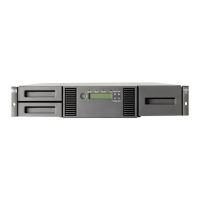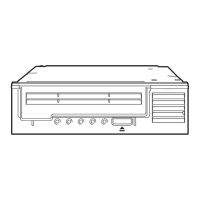topology. It allows for an active intelligent interconnection scheme, called a
fabric, to connect devices. All a Fibre Channel port has to do is to manage a
simple point-to-point connection between itself and the fabric.
Several common ULPs (Upper Level Protocols) including IP and SCSI can be used
with Fibre Channel, merging high-speed I/O and network functionality in a single
connectivity technology.
filemark A mark written by the host. It does not necessarily separate files; it is up to the
host to assign a meaning to the mark.
FL_port Fabric-Loop port. An F_port which is capable of supporting an attached arbitrated
loop. An FL_port on a loop will have the AL_PA 00h, giving the fabric highest
priority access to the loop. An FL_port is the gateway to the fabric for NL_ports
on a loop.
forced eject Functionality in the drive that should unload the cartridge in an emergency of if
the cartridge fails to eject normally. To force ejection, press and hold the Eject
button for 20 seconds. Wait for the cartridge to be ejected. This may take up to
15 minutes (the maximum rewind time).
On full height drives, there is also an emergency reset button—see “Automation
interface” on page 70.
FRU Field Replaceable Unit, an assembly or group of components that is replaced in
its entirety by Service Engineers when it contains a fault.
hard error An uncorrectable data error.
host The host computer system acting as controller for the drive.
L_port Loop port. A generic term for an NL_port or FL_port, in other words, any Fibre
Channel port that supports the arbitrated loop topology.
load The process in which the drive takes in an inserted cartridge and goes online.
LUN Logical Unit Number, by which different devices at a particular SCSI ID can be
addressed individually. The drive has a fixed LUN of 0.
LVD Low-Voltage Differential
N_port Node port. A port on a a device such as a computer system host bus adapter,
disk drive or tape drive, through which the device connects to a point-to-point or
fabric Fibre Channel topology.
network A collection of connected nodes (like workstations, file servers or peripherals)
with its own protocol that supports interaction among these nodes. A network
has relatively high overhead since it is software-intensive, and consequently
slower than a channel. Networks can handle a more extensive range of tasks
than channels as they operate in an environment of unanticipated connections,
while channels operate among only a few devices with predefined addresses.
NL_port Node-Loop port. An N_port which can operate on the arbitrated loop topology.
node A device that has at least one N_port or NL_port.
offline The drive is offline if the tape is currently unloaded or not in the drive. The host
has limited access, and cannot perform any commands that would cause tape
motion. The host can, however, load a tape, if one is inserted, and can execute
any diagnostic tests that do not require tape motion.
Volume 1: hardware integration 161

